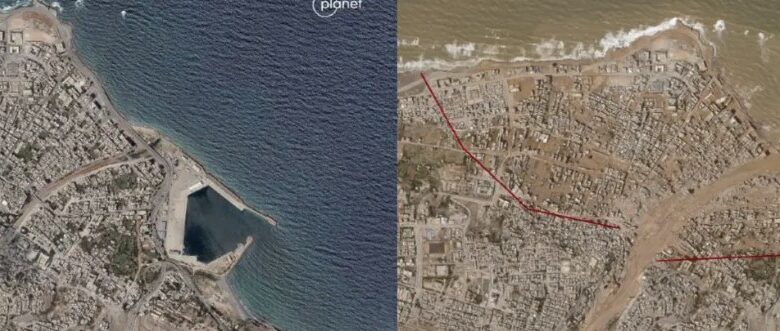The flood in Libya, the Medicane that swept Derna and the role of the climate crisis

At least 5300 flood victims in Libya
(sustainabilityenvironment.com) – At least 5,300 deaths, number updated in the morning of 13 September. But the number will continue to rise as the authorities of Derna recover the bodies still scattered around the city flooded with red mud and those that the sea will return in the coming days. The Derna Sea “constantly dumps dozens of bodies“, said Hichem Chkiouat, Minister of Civil Aviation in the government that commands the eastern part of the country, still split in two by the civil war. The flood victims in Libya could double, say sources from the Interior Ministry of the East. Thousands are still missing.
Flood in Libya: the causes
The moment of flood hits Derna in Libya. #Flood #Libya #Derna pic.twitter.com/VUTIVZfVjW
— JournoTurk (@journoturk) September 11, 2023
The disaster began between Sunday 10 and Monday 11 September with the arrival of Cyclone Daniel. The storm had been raging for days in the central Mediterranean and it is the same storm that caused the violent floods in Greece in the previous days. Most of the plains of Thessaly have been completely flooded, some locations have received in a few hours even over 800 millimeters of rain, more than that of a whole year.
The devastation is as far as the eye can reach. #Derna desperately needs international assistance! Estimates are rising into the thousands of dead. #Libya pic.twitter.com/OgPrTXVmqv
— Anas El Gomati (@AGomati) September 12, 2023
Starting from Saturday, September 9, the cyclone started moving south and hit Cyrenaica, the eastern part of Libya with winds even at 180 km/h. In the meantime, it encountered warmer waters, with temperatures around 28 ºC, which favored the increase in overall energy released by storm Daniel. By the time it hit the ground near Derna, the cyclone had tropical characteristics.
The very violent and consistent rains have collapsed two dams or dams upstream of the city, thus increasing the amount of water that has poured on the urban fabric. From satellite images it is estimated that the water swept away about ¼ Derna.
🇱🇾💧 Before and After the Flood in Derna, Eastern #Libya https://t.co/W8SMq4Egeu pic.twitter.com/VoDYg8fdy0
— Prof. Michael Tanchum (@michaeltanchum) September 13, 2023
Entire neighborhoods have been literally dragged into the sea, with the narrow channel that cuts the city in two that has become a very large wound in an urban fabric now unrecognizable. In other parts of the city the water level would have exceeded 3 meters, damaging hundreds of other buildings and, probably, helping to increase the number of victims.
The role of climate change
Scientific assessments of the role of the climate crisis in the emergence of such an extreme event have not yet been published. Cyclone Daniel is a medicane, a hurricane that forms in the Mediterranean, and according to the latest IPCC report published in 2022 these phenomena should decrease in number due to global warming. But it is also considered likely that the climate crisis, at the same time, will increase its intensity.
One factor that may have contributed to the intensification of the medicane that caused the flood in Libya and that is directly related to the climate crisis is the aforementioned surface water temperature. This year the global oceans have recorded anomalies never reached before and the Mediterranean has not been less. On 24 July the basin reached the highest average recorded temperature of 28.71 ºC. Along the coast of North Africa, as well as along that of Italy, the thermal anomaly of the sea reached 5.5 ºC.
Much clearer is the role of the climate crisis in the damage suffered by the infrastructure in Derna: dams in a poor state of maintenance and not suitable to face phenomena of increased intensity by climate change, which generate a real risk for people.





